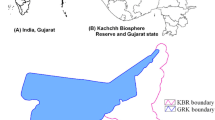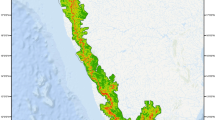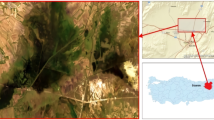Abstract
Wetlands in Kashmir are showing myriad signs of deterioration. In the present study, we assessed the spatio-temporal variations in the land use land cover of a semi-urban Narkara wetland, Kashmir, using high-resolution satellite data of 1965, 1980, and 2016. We also analyzed the impact of land system changes on the health Narkara wetland by estimating soil loss in the catchment of Narkara wetland using Revised Universal Soil Loss Equation (RUSLE) in GIS during the observation period. The land system changes indicated a massive increase of ~ 2663% in built-up area, while the area under agriculture showed ~ 78% decrease between 1965 and 2016. Small insignificant changes were manifest in other land cover types as well. The soil erosion estimates for the wetland catchment for 1965, 1980, and 2016 indicate 106.33 t ha−1 soil detachment for 1965, 120.21 t ha−1 for 1980, and 62.16 t ha−1 for 2016. This significant reduction in the soil erosion is attributed to the barren lands and agriculture being taken over by built-up area between 1980 and 2016. The reckless urbanization both within Narkara and its catchment not only affects the hydrology and ecology of this important semi-urban wetland but also increases vulnerability of people to flooding in this part of Himalaya.









Similar content being viewed by others
References
Amin A, Fazal S, Mujtaba A, Singh SK (2014) Effects of land transformation on water quality of Dal Lake, Srinagar, India. J Indian Soc Remote Sens 42(1):119–128
Azous AL, Horner RR, (eds) (2000) Wetlands and urbanization: implications for the future. 356. CRC Press, Boca Raton
Badar B, Romshoo SA, Khan MA (2013a) Intergrating biophysical and socioeconomic information for prioritizing watersheds in a Kashmir Himalayan lake: a remote sensing and GIS approach. Environ Monit Assess 185:6419–6445
Badar B, Romshoo SA, Khan MA (2013b) Modelling catchment hydrological responses in a Himalayan Lake as a function of changing land use and land cover. J Earth Syst Sci 122(2):433–449
Bourgeau-Chavez LL, Kasischke ES, Brunzell SM, Mudd JP, Smith KB, Frick AL (2001) Analysis of space-borne SAR data for wetland mapping in Virginia riparian ecosystems. Int J Remote Sens 22(18):3665–3687
Chopra R, Verma VK, Sharma PK (2001) Mapping, monitoring and conservation of Harike wetland ecosystem, Punjab, India, through remote sensing. Int J Remote Sens 22(1):89–98
DAIS (2008) Directorate agricultural information services. Directorate Agricultural Land and Resources Management. Directorate Agricultural Information Services, Pretoria, pp 1–7
Dhillon JK, Mishra AK (2014) Estimation of trophic state index of Sukhna Lake using remote sensing and GIS. J Indian Soc Remote Sens 42(2):469–474
Fang G, Yuan T, Zhang Y, Wen X, Lin R (2019) Integrated study on soil erosion using RUSLE and GIS in Yangtze River Basin of Jiangsu Province (China). Arab J Geosci 12(5):173
Fowler HJ, Archer DR (2006) Conflicting signals of climatic change in the Upper Indus Basin. J Clim 19(17):4276–4293
Gao J (1999) A comparative study on spatial and spectral resolutions of satellite data in mapping mangrove forests. Int J Remote Sens 20(14):2823–2833
Hijmans RJ, Cameron SE, Parra JL, Jones PG, Jarvis A (2005) Very high resolution interpolated climate surfaces for global land areas. Int J Climatol 25(15):1965–1978
Hsieh PF, Lee LC, Chen NY (2001) Effect of spatial resolution on classification errors of pure and mixed pixels in remote sensing. IEEE Trans Geosci Remote Sens 39(12):2657–2663
Jain A, Pal J, Sharma E (1999) Hydrology and nutrient dynamics of a sacred lake in Sikkim Himalaya. Hydrobiologia 416:13–22
Jain SK, Kumar S, Varghese J (2001) Estimation of soil erosion for a Himalayan watershed using GIS technique. Water Resour Manag 15(1):41–54
Jenerette GD, Wu J (2001) Analysis and simulation of land-use change in the Central Arizona–Phoenix region, USA. Landsc Ecol 16(7):611–626
Jensen JR (2009) Remote sensing of the environment: an earth resource perspective 2/e. Pearson Education India, New Delhi
Joshi PK, Rashid H, Roy PS (2002) Landscape dynamics in Hokersar Wetland, Jammu & Kashmir-an application of geospatial approach. J Indian Soc Remote Sens 30(1):1–5
Keddy PA (2010) Wetland ecology: principles and conservation. Cambridge University Press, New York
Khan MA (2004) Kashmir Himalayan waterfowl habitat, Hokersar: species composition and threat perceptions. In: Kumar A (ed) Environmental contamination and bioreclamation. APH Publishing Corporation, New Delhi, pp 188–193
Khan MA, Shah MA, Mir SS, Bashir S (2004) The environmental status of a Kashmir Himalayan wetland game reserve: aquatic plant communities and eco-restoration measures. Lakes Reserv Res Manag 9(2):125–132
Khanna S, Santos MJ, Ustin SL, Shapiro K, Haverkamp PJ, Lay M (2018) Comparing the potential of multispectral and hyperspectral data for monitoring oil spill impact. Sensors 18(2):558. https://doi.org/10.3390/s18020558
Khuroo AA, Rashid I, Reshi Z, Dar GH, Wafai BA (2007) The alien flora of Kashmir Himalaya. Biol Invasions 9:269–292
Kumar A, Devi M, Deshmukh B (2014) Integrated remote sensing and geographic information system based RUSLE modelling for estimation of soil loss in western Himalaya, India. Water Resour Manag 28(10):3307–3317
Lindegarth M, Hoskin M (2001) Patterns of distribution of macro-fauna in different types of estuarine, soft sediment habitats adjacent to urban and non-urban areas. Estuar Coast Shelf Sci 52(2):37–247
Millward AA, Mersey JE (1999) Adapting the RUSLE to model soil erosion potential in a mountainous tropical watershed. Catena 38(2):109–129
Mitasova H, Brown WM, Hohmann M, Warren S (2001) Using soil erosion modeling for improved conservation planning: a GIS-based tutorial. Available at: http://www4.ncsu.edu/~hmitaso/gmslab/reports/CerlErosionTutorial/denix/Models%20and%20Processes/RUSLE3d/RUSLE3d.htm. Accessed on: 1st September, 2017
Murtaza KO, Romshoo SA (2017) Recent glacier changes in the Kashmir alpine Himalayas, India. Geocarto Int 32(2):188–205
Mushtaq F, Nee Lala MG, Pandey AC (2015) Assessment of pollution level in a Himalayan Lake, Kashmir, using geomatics approach. Int J Environ Anal Chem 95(11):1001–1013
Najar IA, Khan AB (2012) Assessment of water quality and identification of pollution sources of three lakes in Kashmir, India, using multivariate analysis. Environ Earth Sci 66(8):2367–2378
Ozesmi SL, Bauer ME (2002) Satellite remote sensing of wetlands. Wetl Ecol Manag 10(5):381–402
Pandit AK, Kumar R (2006) Comparative studies on ecology of Hokersar wetland, Kashmir: present and past. Journal of Himalayan Ecology and Sustainable Development 1:73–81
Parihar SM, Sarkar S, Dutta A, Sharma S, Dutta T (2013) Characterizing wetland dynamics: a post-classification change detection analysis of the East Kolkata Wetlands using open source satellite data. Geocarto Int 28:273–287
Patil RJ, Sharma SK, Tignath S (2015) Remote sensing and GIS based soil erosion assessment from an agricultural watershed. Arab J Geosci 8(9):6967–6984
Prachansri S (2007) Analysis of soil and land cover parameters for flood hazard assessment: a case study of the Nam Chun watershed, Phetchabun, Thailand. In: Earth systems analysis. International Institute for geo-information Science and Earth Observation (ITC) Enschede, The Netherlands
Rashid I, Majeed U (2018) Recent recession and potential future lake formation on Drang Drung glacier, Zanskar Himalaya, as assessed with earth observation data and glacier modelling. Environ Earth Sci 77(12):429. https://doi.org/10.1007/s12665-018-7601-5
Rashid H, Naseem G (2007) Quantification of loss in spatial extent of lakes and wetlands in the suburbs of Srinagar City during last century using Geospatial approach. In Proc. of Taal: The 12th World Lake Conference pp. 653–658
Rashid I, Romshoo SA (2013) Impact of anthropogenic activities on water quality of Lidder River in Kashmir Himalayas. Environ Monit Assess 185(6):4705–4719
Rashid I, Romshoo SA, Muslim M, Malik AH (2010) Landscape level vegetation characterization of Lidder valley using geoinformatics. Journal of Himalayan Ecology and Sustainable Development 6:11–24
Rashid I, Farooq M, Muslim M, Romshoo SA (2013) Assessing the impact of anthropogenic activities on Manasbal Lake in Kashmir Himalayas. Int J Environ Sci 3(6):2052–2063
Rashid I, Romshoo SA, Chaturvedi RK, Ravindranath NH, Sukumar R, Jayaraman M, Lakshmi TV, Sharma J (2015) Projected climate change impacts on vegetation distribution over Kashmir Himalayas. Clim Chang 132(4):601–613
Rashid I, Romshoo SA, Hajam JA, Abdullah T (2016) A semi-automated approach for mapping geomorphology in mountainous terrain, Ferozpora watershed (Kashmir Himalaya). J Geol Soc India 88(2):206–212
Rashid I, Bhat MA, Romshoo SA (2017a) Assessing changes in the above ground biomass and carbon stocks of Lidder valley, Kashmir Himalaya, India. Geocarto Int 32(7):717–734
Rashid I, Romshoo SA, Amin M, Khanday SA, Chauhan P (2017b) Linking human-biophysical interactions with the trophic status of Dal Lake, Kashmir Himalaya, India. Limnologica-Ecology and Management of Inland Waters 62:84–96
Rashid I, Romshoo SA, Abdullah T (2017c) The recent deglaciation of Kolahoi valley in Kashmir Himalaya, India in response to the changing climate. J Asian Earth Sci 138:38–50
Rather MI, Rashid I, Shahi N, Murtaza KO, Hassan K, Yousuf AR, Romshoo SA, Shah IY (2016) Massive land system changes impact water quality of the Jhelum River in Kashmir Himalaya. Environ Monit Assess 188(3):1–20
Renard KG, Foster GR, Weesies GA, McCool DK, Yoder DC (1997) Predicting soil erosion by water: a guide to conservation planning with the revised universal soil loss equation (RUSLE), vol 703. US Government Printing Office, Washington, DC
Romshoo SA, Muslim M (2011) Geospatial modeling for assessing the nutrient load of a Himalayan lake. Environ Earth Sci 64(5):1269–1282
Romshoo SA, Rashid I (2014) Assessing the impacts of changing land cover and climate on Hokersar wetland in Indian Himalayas. Arab J Geosci 7(1):143–160
Romshoo SA, Ali N, Rashid I (2011) Geoinformatics for characterizing and understanding the spatio-temporal dynamics (1969 to 2008) of Hokersar wetland in Kashmir Himalayas. Int J Phys Sci 6(5):1026–1038
Romshoo SA, Bhat SA, Rashid I (2012) Geoinformatics for assessing the morphometric control on hydrological response at watershed scale in the Upper Indus Basin. J Earth Syst Sci 121(3):659–686
Romshoo SA, Dar RA, Rashid I, Marazi A, Ali N, Zaz SN (2015) Implications of shrinking cryosphere under changing climate on the streamflows in the Lidder catchment in the Upper Indus Basin, India. Arct Antarct Alp Res 47(4):627–644
Romshoo SA, Altaf S, Rashid I, Dar RA (2017) Climatic, geomorphic and anthropogenic drivers of the 2014 extreme flooding in Jhelum basin of Kashmir, India. Geomatics, Natural hazards and Risk 9(1):224–248
Romshoo SA, Rafiq M, Rashid I (2018) Spatio-temporal variation of land surface temperature and temperature lapse rate over mountainous Kashmir Himalaya. J Mt Sci 15(3):563–576
Roose EJ (1977) Use of the universal soil loss equation to predict erosion in West Africa. In: soil erosion: prediction and control, vol 21. Soil conservation Society of America, Ankeny, pp 60–74
Schmidt S, Nüsser M (2012) Changes of high altitude glaciers from 1969 to 2010 in the Trans-Himalayan Kang Yatze Massif, Ladakh, Northwest India. Arct Antarct Alp Res 44(1):107–121
Showqi I, Rashid I, Romshoo SA (2014) Land use land cover dynamics as a function of changing demography and hydrology. GeoJournal 79(3):297–307
Singh G, Chandra S, Babu R (1981) Soil loss and prediction research in India. Central Soil and Water Conservation Research Training Institute, Bulletin No. T-12/D9
Stone RP (2012) Universal soil loss equation (USLE) factsheet. Ontario ministry of agriculture, food and rural affiars (OMAFRA). ISSN: 1198-712X. Available at: http://www.omafra.gov.on.ca/english/engineer/facts/12-051.htm accessed on: 21st august, 2017
Stone RP, Hilborn D (2000) Universal soil loss equation (USLE). Ontario Ministry of Agriculture, Food and Rural Affairs Factsheet
Teng H, Liang Z, Chen S, Liu Y, Rossel RAV, Chappell A, Yu W, Shi Z (2018) Current and future assessments of soil erosion by water on the Tibetan Plateau based on RUSLE and CMIP5 climate models. Sci Total Environ 635:673–686
Vass KK, Wangeneo A, Samanta S, Adhikari S, Muralidhar M (2015) Phosphorus dynamics, eutrophication and fisheries in the aquatic ecosystems in India. Curr Sci 108(7):1306–1314
Vörösmarty CJ, McIntyre PB, Gessner MO, Dudgeon D, Prusevich A, Green P, Glidden S, Bunn SE, Sullivan CA, Reidy Liermann C, Davies PM (2010) Global threats to human water security and river biodiversity. Nature 467(7315):555–561
Wischmeier WH, Smith DD (1978) Predicting rainfall erosion losses-a guide to conservation planning. Agric Handb 537:1–58
Zedler JB, Kercher S (2005) Wetland resources: status, trends, ecosystem services, and restorability. Annu Rev Environ Resour 30:39–74
Zhou P, Luukkanen O, Tokola T, Nieminen J (2008) Effect of vegetation cover on soil erosion in a mountainous watershed. Catena 75(3):319–325
Acknowledgments
The authors express gratitude to the United States Geological Survey (USGS) for freely providing the earth observation data for the present analysis. The authors thank Dr. Ashty Saleem, the associate editor, and other two anonymous reviewers for their valuable comments and suggestions on the earlier versions of the manuscript that greatly improved the content and structure of this manuscript.
Author information
Authors and Affiliations
Corresponding author
Additional information
Editorial handling: Joseph Awange
Rights and permissions
About this article
Cite this article
Rashid, I., Aneaus, S. High-resolution earth observation data for assessing the impact of land system changes on wetland health in Kashmir Himalaya, India. Arab J Geosci 12, 453 (2019). https://doi.org/10.1007/s12517-019-4649-9
Received:
Accepted:
Published:
DOI: https://doi.org/10.1007/s12517-019-4649-9




